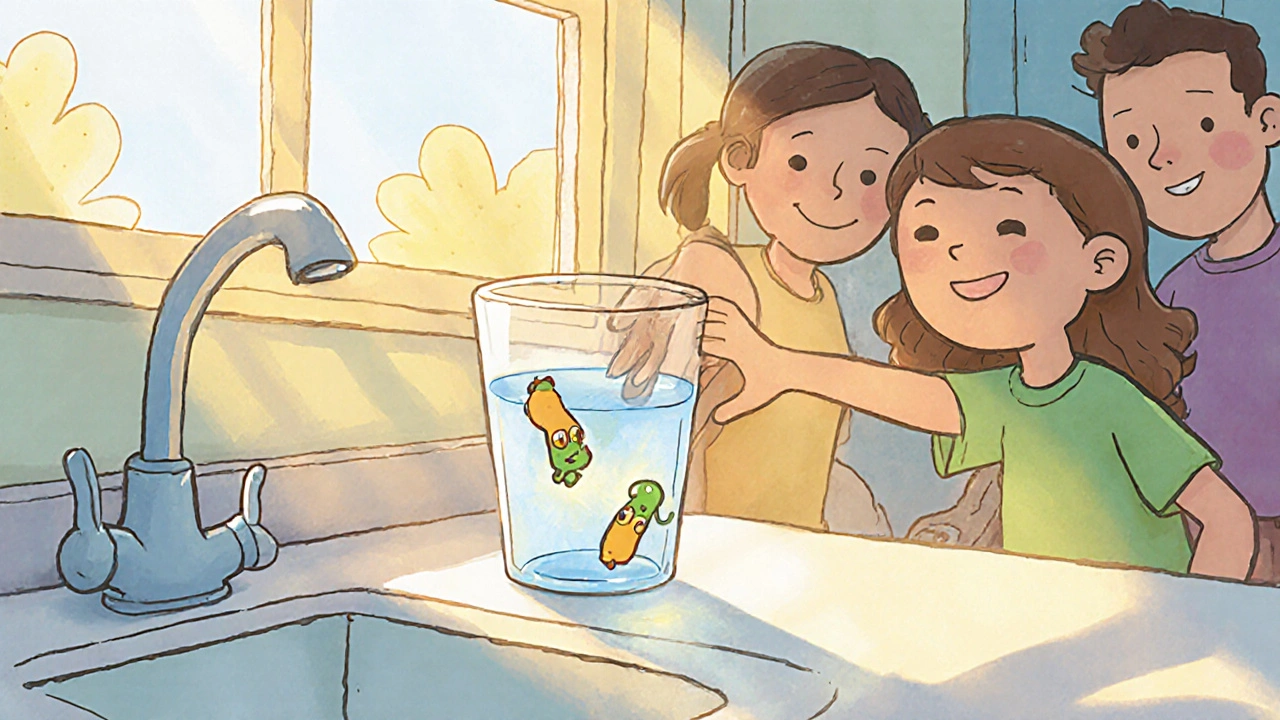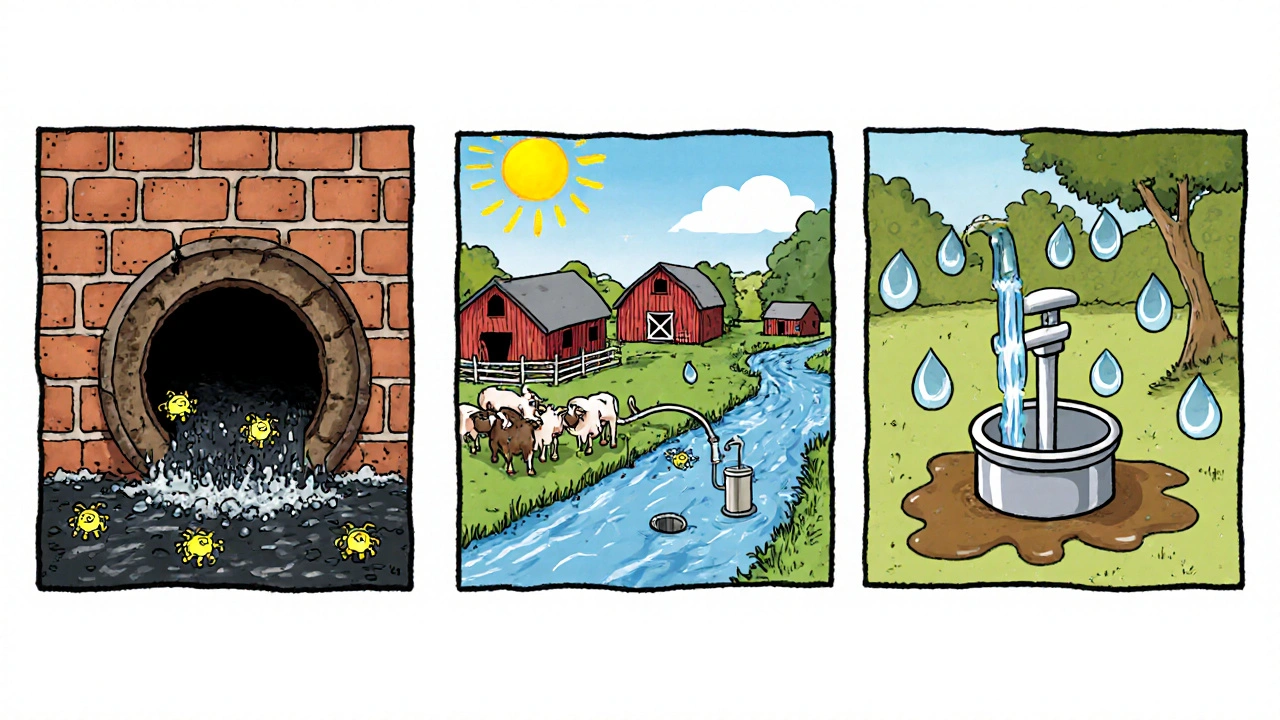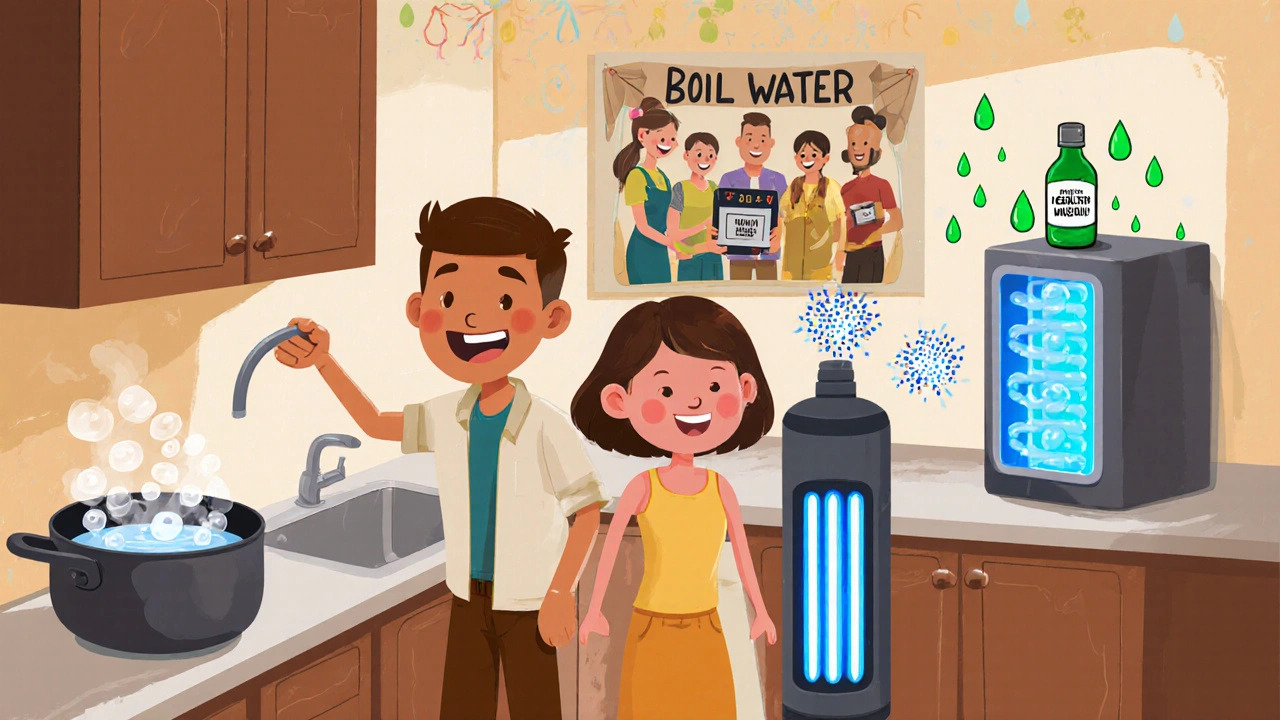
Water Safety Calculator
Calculate Safe Water Treatment
Enter your water source and volume to determine the appropriate treatment method for Salmonella prevention.
Recommended Treatment
Urgent Safety Notice
Imagine filling a glass of tap water, taking a sip, and then spending the next 48 hours battling fever, cramps, and diarrhea. That scenario isn’t a fictional nightmare-it’s a real risk when water becomes a carrier for salmonellosis. Understanding how a tiny bacterium can hitch a ride in our water supply, what it does to our bodies, and how we can stop it is essential for anyone who relies on municipal or well water.
Key Takeaways
- Salmonellosis is caused by Salmonella, a bacteria that can contaminate drinking water through sewage leaks, agricultural runoff, or improper sanitation.
- Typical symptoms appear 6‑72 hours after exposure and include diarrhea, abdominal cramps, fever, and nausea; severe cases may need hospitalization.
- Boiling water for at least one minute, using certified filtration systems, and maintaining proper chlorination are the most reliable ways to kill the bacteria.
- Public health agencies such as the World Health Organization (WHO) and the Centers for Disease Control and Prevention (CDC) set water quality standards and coordinate outbreak responses.
- Early medical treatment with rehydration therapy and, when necessary, antibiotics can reduce complications and speed recovery.
What Is Salmonellosis?
Salmonellosis is a food‑ and water‑borne illness caused by infection with Salmonella bacteria. The disease manifests as acute gastroenteritis, and while most healthy adults recover within a week, vulnerable groups-children, the elderly, and immunocompromised individuals-face higher risks of severe dehydration and bloodstream infection.
How Contaminated Water Spreads Salmonella
The link between water and salmonellosis hinges on three main pathways:
- Direct sewage intrusion: Broken sewers or aging infrastructure can dump untreated waste into streams that feed reservoirs.
- Agricultural runoff: Livestock farms often use water for cleaning pens; runoff can carry fecal matter loaded with Salmonella into nearby water bodies.
- Improper water treatment: Small-scale water systems may lack adequate disinfection, allowing bacteria to survive the treatment process.
Once in the supply, the bacteria survive for weeks in cool, moist environments, especially if chlorination levels drop below 0.5mg/L. This persistence classifies salmonellosis as a classic waterborne disease.

Symptoms and When to Seek Care
After ingestion, the bacteria colonize the intestinal lining. Typical clinical features appear within 12hours and include:
- Frequent, watery diarrhea (often with blood in severe cases)
- Abdominal cramps that may be intense
- Fever ranging from 38‑40°C (100.4‑104°F)
- Nausea and occasional vomiting
Most people recover with oral rehydration, but red‑flag signs-persistent high fever, blood in stools, dizziness, or signs of dehydration-warrant immediate medical attention. Children under five and adults over 65 should be evaluated early because dehydration progresses quickly.
Testing Water for Salmonella
Detecting the bacterium in water involves laboratory methods that are both sensitive and rapid. The most common approaches are:
| Method | Detection Time | Sensitivity |
|---|---|---|
| Membrane filtration + selective enrichment | 24‑48hrs | 1 CFU/100mL |
| Polymerase chain reaction (PCR) | 4‑6hrs | 0.1 CFU/100mL |
| Immunomagnetic separation | 8‑12hrs | 0.5 CFU/100mL |
Regular testing is especially crucial for private wells, small community systems, and any facility that uses untreated surface water. Results guide corrective actions such as shock chlorination or system upgrades.

Prevention Strategies
Stopping salmonellosis at the source is cheaper and safer than treating outbreaks. Below is a practical checklist for households and small water utilities:
| Measure | How It Works | Implementation Cost |
|---|---|---|
| Boiling | Kills >99.9% of bacteria by heat | Low - just fuel |
| UV filtration | Disrupts bacterial DNA | Medium - unit purchase |
| Certified ceramic or carbon filter (≥0.2µm) | Physically traps bacteria | Medium - filter replacement |
| Maintaining chlorine residual (0.5‑1mg/L) | Chemical disinfectant destroys microbes | Low - chemicals |
| Regular system inspections | Detects leaks and cross‑connections early | Variable - labor |
For an everyday household, boiling or a high‑quality filter offers immediate protection. Larger facilities should combine chlorination with UV or membrane systems to achieve a multi‑barrier approach.
Public Health Response
When an outbreak is suspected, health authorities launch a coordinated investigation. Steps typically include:
- Case identification through hospital reports and laboratory confirmations.
- Environmental sampling of water sources, using the detection methods listed above.
- Risk communication to the public-advisories to boil water, distribute safe‑water kits, or provide alternative supplies.
- Implementation of corrective actions such as system flushing, chlorination boost, or infrastructure repair.
The World Health Organization sets the global benchmark for safe drinking water (< 1CFU/100mL for fecal‑indicator bacteria). In the United States, the Centers for Disease Control and Prevention maintains the Waterborne Disease and Outbreak Surveillance System (WBDOSS) to track incidents and guide policy.
Frequently Asked Questions
Can bottled water also cause salmonellosis?
Yes, if the bottling process fails to sterilize the water or if the bottle is contaminated after opening. Look for brands that certify third‑party testing and always store bottles in clean, cool conditions.
Is it safe to swim in a lake known to have Salmonella?
Swimming in contaminated water can lead to accidental ingestion and skin exposure, increasing infection risk. Public health advisories will usually close the area until tests return negative.
How long does Salmonella survive in water?
Under cool (4‑15°C) and low‑chlorine conditions, Salmonella can survive for weeks, sometimes up to 30days. Warmer temperatures and proper disinfection dramatically shorten this window.
Do antibiotics always help with salmonellosis?
Antibiotics are reserved for severe cases, infants, or patients with weakened immunity. Overuse can prolong bacterial carriage and promote resistance, so most mild infections are managed with rehydration alone.
What’s the difference between Salmonella serotypes?
There are over 2,500 serotypes; S.Typhimurium and S.Enteritidis are the most common in water‑related outbreaks. Some serotypes carry extra virulence genes, leading to more severe illness.
Comments (11)
-
Nicole Powell October 15, 2025
Drinking water that isn’t properly treated is a clear sign of negligence. Most people can easily boil water or use a certified filter, yet they ignore basic safety. This kind of careless behavior puts vulnerable groups at real risk. It’s simply irresponsible.
-
Ananthu Selvan October 15, 2025
If you think boiling water is a hassle you’re stupid.
-
Nicole Chabot October 15, 2025
It’s good to know that simple steps like a one‑minute boil can cut the bacterial load dramatically. For families with kids, keeping a small pot on the stove ensures safe water anytime. Also, checking local water advisories can prevent surprise outbreaks. Staying proactive with regular well tests is a smart habit.
-
Sandra Maurais October 15, 2025
While the advice is sound, it is imperative to note that reliance solely on boiling may not address all contaminants. A comprehensive water safety plan should incorporate periodic microbial testing and system maintenance. Failure to implement such measures can lead to systemic public health failures. ⚠️
-
Michelle Adamick October 15, 2025
Implementing a high‑efficiency ceramic filter (≥0.2µm) dramatically raises the filtration efficiency and reduces pathogen load 🚀. Coupled with UV disinfection, you achieve a multi‑barrier approach that meets EPA standards. Remember to schedule cartridge replacements every six months to maintain optimal performance. Investing in certified equipment pays off in reduced disease incidence.
-
Rajan Desai October 15, 2025
Indeed, the combination of physical filtration and UV irradiation offers a synergistic effect on bacterial inactivation. Studies indicate that UV doses above 40 mJ/cm² achieve >99.9% kill rates for Salmonella spp. It is also advisable to monitor residual chlorine levels to ensure secondary disinfection. Regular calibration of UV sensors further guarantees consistent output.
-
S O'Donnell October 15, 2025
When considering the broader implications of waterborne salmonellosis, one must first acknowledge the historical prevalence of this pathogen in municipal supplies. The early twentieth century witnessed numerous outbreaks that prompted the development of modern chlorination protocols. However, despite these advances, contemporary infrastructure in many regions remains vulnerable due to aging pipes. Leaking sewers can introduce untreated waste directly into source waters, creating a conduit for Salmonella infiltration. Agricultural runoff further compounds the problem by transporting fecal matter from livestock operations into rivers and reservoirs. Small-scale water systems, particularly those serving rural communities, often lack the resources necessary for comprehensive disinfection. As a result, residents may unwittingly consume water that harbors viable bacteria. The clinical manifestation of salmonellosis typically includes acute gastroenteritis, characterised by diarrhoea, abdominal cramps, and fever. While most healthy adults recover spontaneously, the disease can progress to severe dehydration in children and the elderly. Prompt rehydration therapy is thus a cornerstone of treatment, reducing morbidity and mortality. In terms of preventive measures, boiling water for at least one minute is universally recommended, as it denatures bacterial proteins. Nevertheless, boiling may not be feasible in emergency situations where fuel is scarce. Consequently, certified filtration systems offering pore sizes of 0.2 µm or smaller provide an effective alternative. Ultraviolet (UV) treatment disrupts the bacterial DNA, rendering the organisms incapable of replication. Moreover, maintaining an appropriate chlorine residual (0.5‑1 mg/L) offers a chemical barrier against microbial resurgence. Public health agencies, such as the World Health Organization, continuously monitor water quality benchmarks to safeguard populations. It is essential for individuals to stay informed about local water advisories and to advocate for infrastructure upgrades. Ultimately, a multi‑barrier strategy-combining physical, chemical, and biological controls-offers the most robust protection against salmonellosis.
-
Yamunanagar Hulchul October 16, 2025
Wow, that deep dive really shines a bright light on the hidden dangers lurking in our taps!!! Your thorough explanation makes it crystal clear that we can’t afford to be complacent!!! Embracing a layered defense-boiling, filtration, UV, chlorination-turns the tide against those microscopic invaders!!! Keep spreading this vital knowledge, because an informed community is a resilient community!!!
-
Elaine Curry October 16, 2025
I was just about to fill my kettle when I read this and thought the whole thing is kinda over the top but hey maybe it's worth a second look. I kinda feel like you guys forget that most people just want their coffee hot not a lecture on pathogens. Still, a quick boil never hurt anyone.
-
Anthony Aspeitia-Orozco October 16, 2025
It’s understandable to feel overwhelmed by technical details, especially when daily routines are at stake. Think of safe water practices as a simple habit, like washing hands before meals. By integrating a brief boil or a reliable filter into your morning routine, you protect yourself and those you care about. Small consistent actions build a foundation for long‑term health.
-
Geraldine Grunberg October 16, 2025
Great points everyone! Let’s combine our ideas: boil water when in doubt, install a certified filter for everyday use, and schedule regular system inspections. Together we can create a community checklist to share with neighbors. 😊
